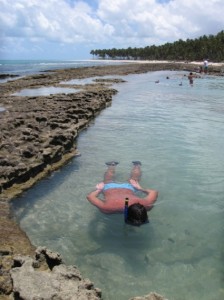
Photo © Michael Sommers.
Wandering along the paradisiacal beaches of northern Alagoas – some of the most beautiful in Brazil – one expects to encounter sea shells, sand dollars, fallen coconuts – anything but explosive mines. However, this is precisely what construction workers in Maragogi, a former fishing village and current tourist hot spot, uncovered earlier this year while digging deep into the sand. Although the mine was subsequently (and very delicately) extricated by a police bomb squad, and taken off to an isolated beach where it was promptly detonated, subsequent investigations by the Brazilian Navy last month turned up another five sea mines in the center of town and on the main beach.
The mines – gigantic metal balls that measure 1 meter in diameter and weigh 100 kg – date back to the 1940s. During the Second World War, records show that the Brazilian Navy placed a total of seven mines along the coast of Maragogi as a defensive measure against invading German ships. Concerned with potential accidents, at the time, local fishermen buried the mines on a secluded patch of beach. As decades passed, residents forgot about the mines and the formerly abandoned areas where they lay buried became urbanized.
Meanwhile, the fact that the “mined city” has made national headlines is a concern for the region’s tourist industry.Their rediscovery – which quickly earned Maragogi the droll, if dubious, nickname of “cidade minada” (mined city) – has divided the local population. While some residents, such as a young teacher whose school is located in front of one of the mines, confess that the thought of living in a minefield is unnerving, others are as unfazed as the street vendor who sells homemade snacks in front of a second mine and whose philosophical argument is that “if they haven’t exploded in the last 70 years, why would they explode now?”
Meanwhile, the fact that the “mined city” has made national headlines is a concern for the region’s tourist industry. Maragogi is Alagoas’ second-most popular tourist destination (after the capital, Maceió, located 130km south) due its strategic location along the Costa dos Corais (Coral Coast), a coastline renowned for its limpid turquoise ocean pools framed by coral reefs (known as “the Galés”). Accessible by boat (or on foot when the tide is low), these reefs – part of a 135-km extension of federally protected coral that stretches from northern Alagoas up to southern Pernambuco – are a snorkeler’s paradise that draw visitors from all over Brazil and abroad.
Executive manager of the trade and tourist association of Alagoas’ northern coast, Mariana Goldstein is particularly worried about the mines’ effects on tourism. As such, she breathed a giant sigh of relief when it was announced that in early October, a special team of explosive specialists from Rio de Janeiro will be on arriving in Maragogi to preside over a team of engineers whose mission is to safely dig up, remove, and detonate the offending mines (an operation that is expected to last 3-4 weeks).
This isn’t to say, however, that Goldstein wants the memory of the mines to be swept away as soon as possible. Rather, she and other members of the tourist association hope to take advantage of the situation by transforming the mines into the area’s newest – and oddest – tourist attraction. “I think we should emphasize the historic value of these mines. We could create a museum that recounts their history against a backdrop of Brazil’s participation in the Second World War,” she announced this week. If it comes to fruition, at the very least the plan will bring a new layer of meaning to the expression “exploding tourism.”